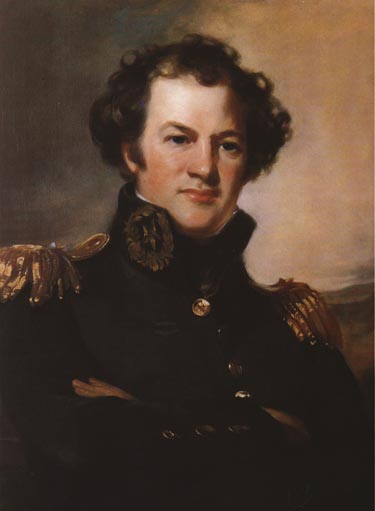
Alexander Macomb was born in British-held Detroit on 3 April 1782; moved with his parents to New York City and received a classical education at a Newark (New Jersey) academy; enrolled at age sixteen in a New York militia company; at Alexander Hamilton’s recommendation during the emergency with France, was commissioned a cornet in the Regular Army, January 1799, and promoted to second lieutenant in March; was honorably discharged, June 1800; was commissioned a second lieutenant, 2d Infantry, February 1801, and served as secretary to a commission that treated with the Indians of the Southeast; was commissioned a first lieutenant in the Corps of Engineers, established in 1802 at West Point to constitute a military academy, and was thus one of the first officers to receive formal training there; married a cousin, Catharine Macomb, 1803; was promoted to captain, June 1805, major, February 1808, and lieutenant colonel, July 1810, in the Corps of Engineers; was chief engineer in charge of coastal fortifications in the Carolinas and Georgia, 1807–1812; was acting adjutant general of the Army, April–July 1812; was appointed colonel, 3d Artillery, July 1812, and transferred to the field; commanded American troops at Sackett’s Harbor and participated in the capture of Fort George and in General James Wilkinson’s St. Lawrence campaign, 1813; was promoted to brigadier general, January 1814, and assigned to the Lake Champlain area; repulsed a superior British force at Plattsburg, New York, September 1814, for which he received a brevet major generalcy; as a token of thanks, was awarded a gold medal by Congress, November 1814; was a member of a board on Army reorganization, then commanded the Third Military District at New York and the Fifth at Detroit; became chief of engineers with the rank of colonel, June 1821; married his second wife, Harriet Balch Wilson, 1826; was promoted to major general, May 1828; was commanding general of the United States Army, 29 May 1828–25 June 1841; espoused the position that the commanding general should have active command of the whole Army including the staff bureaus, under the loose supervision of the secretary of war; recommended a doubling of Army strength to hold the Indians in check, increases in enlisted pay to discourage desertion, augmentation of officers in the service branches to free line officers for field duty, relief for widows and orphans of Regular officer victims of wounds and disease, and a system of officer retirement and replacement; died while in office at Washington, D.C., on 25 June 1841.
The Artist
Thomas Sully (1783–1872) was born in England and came to America with his family when he was ten. He received his early art instruction from an older brother and a brother-in-law, both of artistic talent, and after a formative period in Richmond and Norfolk, Virginia, he moved to New York City to enter the mainstream of his career as a portraitist. He met and received valuable guidance from Gilbert Stuart in Boston and Benjamin West in London, and his introduction to Sir Thomas Lawrence opened the way to commissions for portraits of a number of important people. He established his home base in Philadelphia, where he painted the Marquis de Lafayette among others, and reached the pinnacle of his career on a second trip to England to paint Queen Victoria. His portrait of General Alexander Macomb is in the collections of the West Point Museum, United States Military Academy.
Alexander Macomb
By Thomas Sully
Oil on canvas, 30" x 25", 1829
[72]

page updated 30 April 2001